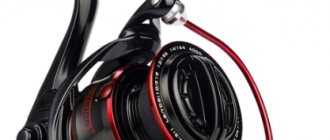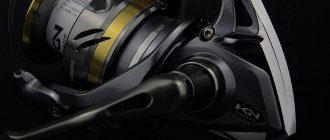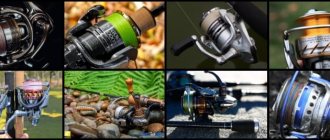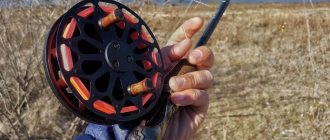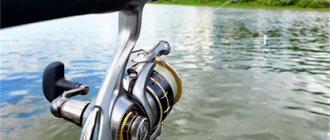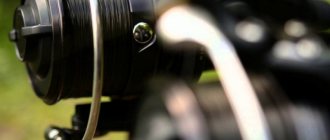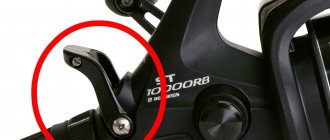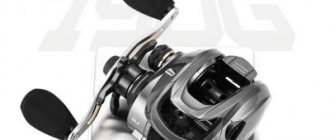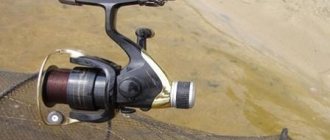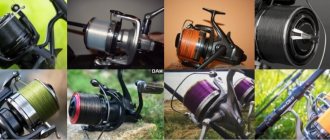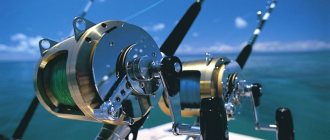Types of spinning reels
All spinning reels are classified into three categories:
- Inertial . They are gradually disappearing from use among fishermen due to the fact that they are not very convenient to use.
- Inertialess . This is the most common type of reel used by most anglers.
- Multiplier.
Inertia coils
In reels of this type, the spool with fishing line is located perpendicular to the casting direction. After the bait reaches the casting point, it continues to rotate by inertia. If you do not brake it in time with your finger, the line may become tangled. Spinning rods with such reels are used as hooks for catching peaceful fish.
A regular inertial coil is the most affordable and reliable option.
Advantages:
- Reliability and reliability.
- Durability.
- Simple device.
- Capacious drum for fishing line.
Flaws:
- More complex casting technique.
- Low line rewind speed.
- It is problematic to cast light baits.
- Large reel size.
- It is difficult to make long casts.
Spinning reels
This reel works on the principle that the line comes off the spool. The spool itself is located in the same plane as the casting direction, so the line does not encounter resistance when casting. Holding the line with your finger and throwing back the bow, swing and throw. At the moment when the load carries the fishing line along with it, the finger is released. After casting, the bow returns to its place.
Shimano IX spinning reel
After this, the line is captured by the roller, and winding of the line onto the spool begins. Spinning reels can be used for any type of fishing. They are suitable for feeder and spring fishing, as well as for catching predatory fish. They go with them to catch pike, perch, pike perch and chub.
Based on rotation speed, coils are divided into three types:
- Slow-moving. Used for heavy loads. The gear ratio is in the range of 3.2-4.3.
- Universal. Can be used for any cargo. The gear ratio is 4.5-6.1.
- Express. Used for light gear. Gear ratio - more than 6.
Advantages:
- There is no inertia when casting, and tangling of the line is avoided.
- The casting distance is controlled by the angler himself.
- You can make very long casts.
- Loads of any weight are used.
- Post-casting is carried out at the speed required at the moment.
- The presence of a friction clutch helps prevent line breaks when large fish bite.
Flaws:
- The line on such a reel is constantly twisting.
- The cost of a quality reel is very high.
Multiplier reels
This is also an inertial coil, but more advanced and complex. It is equipped with a braking mechanism that prevents the line from getting tangled. True, in some cases, for example, when a load breaks, the fishing line can still get tangled.
Lew's Fishing Bait Reel. Price from 6000 rubles.
The spool of such a reel is also located perpendicular to the casting line. The work is controlled by a system of gears that transmit force from the handle to the drum. Thanks to this, the force that the angler applies to the handle is multiplied.
There are 2 types of such coils:
- "Kegs." They are larger in size, used for catching large fish, and are distinguished by their reliability and good traction.
- "Soap boxes." Their purpose is fishing with low and medium loads.
Advantages:
- More durable and reliable than a spinning reel.
- The line does not twist when coming off the spool.
- High sensitivity, since the force from the fishing line goes directly to the drum, and not to the roller.
- Allows the use of heavy weights.
- It has compact dimensions and light weight.
Flaws:
- The braking system must be adjusted taking into account the weight of the sinker and casting conditions.
- Ineffective work with very light loads (up to 6 g).
- It is difficult to change the line with a spinning reel, so at first there will be “beards” on the line.
- High price.
How to choose the right spinning reel
It's time to figure out how best to choose a reel for your spinning rod and what points to focus on.
To choose a good reel, you need to pay attention to its components:
- Frame. It is made non-separable. Materials: metal or composite.
- Spool. The fishing line is stored on it. The spool is made of metal or plastic with the addition of graphite and composite materials. If braided cord is used, the spool should be metal. The size of the spool determines the amount of fishing line that can be wound on it. The larger the spool size, the greater the capabilities of the reel. The presence of a spare spool allows you to place a fishing line of a different diameter on it, which increases the efficiency of fishing.
- Friction. It allows you to release the reel clamp, as a result of which the fishing line will be released from it. This happens at those moments when the load on the fishing line and the reel itself exceeds the permissible limit. After the load is released, the friction brake is turned off, allowing you to land fish. The clutch is tightened with a nut. The friction brake can be located at the front or rear of the reel. The most convenient and reliable is the front clutch.
- Bearings. A high-quality reel has at least 4 bearings. They are located in the line guide, on the rotor gear, in the handle, and in the roller.
- Line laying machine. Consists of a bow, a roller and a spring. Pay attention to the operation of the line layer, since the bow of a low-quality device may suddenly slam shut when casting. The result of this slamming is the loss of the load and attachment. Be sure to check the operation of the mechanism before purchasing. To do this, fold back the bow as before casting, and then make several sharp movements with your hand. If the bow does not slam shut, the coil has passed the test. The roller must rotate freely, otherwise the cord or fishing line will quickly fray it. To make it rotate easily, a bearing is installed inside it.
- Reel handle. The most convenient is the replaceable handle, which can be changed for convenience to suit any hand.
- Reverse stopper. Prevents the handle from rotating in the opposite direction.
- Drive gear. It must be made of brass. If it is aluminum or plastic, the reel will not last long. The gear is located under the spool and can be easily inspected by removing the spool.
- Bayrunner. This is a device for releasing fishing line from a reel. Usually used when catching large fish. Prevents the rod from being dragged into the water. When the baitrunner is turned off, the reel operates normally. When the baitrunner is turned on, the spool rotates, allowing the line to flow out. The baitrunner looks like a bracket on the back of the reel. It complements the friction brake, but is configured, unlike it, for instant line return. The force of rotation of the spool is adjusted by turning the tightening mechanism. Mounted on very powerful reels.
It will also be useful to know about the following product characteristics:
- Gear ratio. This is the ratio of the number of revolutions of the spool to the number of revolutions of the reel handle. If the ratio is about 6, then the reel is considered high-speed, more suitable for light fishing rods. For spinning rods, it is recommended to choose a medium gear ratio (4-5). For catching large fish, for casting, it is better to use reels with a low gear ratio (3-4), which provide high resistance to power loads.
- Marking. The following information is indicated on the product packaging:
- The numbers separated by a slash indicate how many meters of fishing line of the indicated diameter can be placed on the spool. So, the designation 0.3/100 means that 100 m of fishing line with a diameter of 0.3 mm will fit.
- “Ball bearing” - number of bearings.
- Numbers separated by a colon, for example 1:4.2, indicate the gear ratio.
- Smooth ride. It is necessary to select the reel in such a way that when turning the handle there is no jerking, and the line is laid evenly.
- Bite alarm. Some reel models have built-in bite alarms. They only work if the fish comes from the shore. Well suited for feeder fishing. The indicator does not work on gear mounted “hard”.
The main thing in choosing a reel
The main thing you need to pay attention to when wondering how to choose a reel for a spinning rod is the smoothness of the move, and how smoothly it lays the braided cord. It is definitely worth carrying out the operation of winding the braid in the store, and you should not wind the usual monofilament fishing line, since its reels are laid more evenly, but the braid lies on the spool more tightly and all the flaws in the winding immediately become visible.
When winding, the reel should rotate easily, without jamming or unnecessary sounds, that is, when you rotate it, nothing should confuse you .
Previously, for even laying, the reel mechanism had to have an endless screw, but recently quite a lot of reels have appeared that lay the line efficiently without it.
If you are going to use a braided line, then the spool should only be metal; if you are fishing with a fishing line, then a plastic one will do. It is very good when the reel is coated with titanium nitride on the sides of the spool and the line guide, it improves glide and the braid rubs less when casting and rotating the reel.
Each spool has an inscription indicating how much fishing line of a certain diameter can be wound on it. Often the number indicates the length of the monofilament line, so it is worth considering that less braid will fit (since, very often, due to design features, its real diameter does not coincide with the diameter declared by the manufacturer, and it takes up more space on the spool than monofilament line same diameter).
When we pick up a reel, we evaluate its weight. A lightweight reel is very good, but excessive lightness indicates that it is made of plastic and its durability leaves much to be desired. True, now you can increasingly find reels made from modern lightweight but strong materials (for example, reels with a magnesium body). Such reels are expensive, so if you choose a budget reel option, you should take heavier models made of metal.
How to choose a reel for a spinning rod
In order for your fishing to be successful, and for you not to experience difficulties with casting and landing fish, you need to choose the right spinning rod and reel. More precisely, combine the reel with an existing spinning rod.
Spinning reels are divided into classes:
- Class 500. They weigh less than 170 g. They are used on light ultralight spinning rods.
- Class 1000-1500. Used on light and ultralight spinning rods.
- Class 2000. It is universal and can be used on the vast majority of spinning rods.
- Class 3000-4000. Used with powerful feeder type rods.
- Class 4500. Mounted on a very thick and durable fishing rod. Suitable for fishing for very large fish, such as catfish or silver carp.
If you use a lightweight rod, then you should choose a lightweight reel. For example, if the length of the spinning rod is less than 2.5 m, a 500-1500 class reel is best suited for it. If the rod has a length of 2.5-3.5 m, then a reel of class 2500 would be ideal. For a longer rod or if the spinning rod is thick, a reel class of 3000 or more is selected.
The best reel manufacturers
The Japanese brands Daiwa, Shimano and Rioby are considered recognized leaders in the production of reels:
- Daiwa. Produces more than 50 reel models. The company's products are distinguished by their smooth running, noiselessness and ergonomics. The reels contain many plastic parts, so they are short-lived and susceptible to mechanical stress. Their cost is quite high.
- Rioby . A special feature of Rioby reels is the use of only high-quality components for their production. The products are characterized by smooth running and resistance to high loads.
- Shimano. The reels are light in weight but highly reliable. The acceptable cost of the products and their durability are noted. Multiplier reels from this company are overpriced.
Coil size
Before choosing a reel, you need to decide on its size. The power of the product and its other indicators depend on this. Special units of measurement in thousands are used to indicate size. The most successful classification is considered to be from Shimano and Daiwa.
You may be interested in: Zander baits
Reels 1000-2500 are designed for light spinning, working with small baits and catching small fish. If you are looking for which reel to choose for spinning with medium or heavy baits, it is worth considering options in sizes 3000-5000. Large sizes are usually not suitable for spinning rods and are used in sea fishing and carp fishing.
Reel prices
Here is a list of some quality reels for spinning fishing:
- Daiwa Sweepfire 2500B. It has an IF 5.3:1, only 1 bearing, a spool with a capacity of 0.5 mm/150 m. Cost - 600 rubles.
- Salmo Diamond Baitfeeder 6 30Br. Bearings - 5+1, IF - 5.2:1, weight - 375 g, spool - 0.25 mm/250 m. Cost - 1900 rubles.
- RYOBI Ecusima 1000. Bearings - 4+1, frequency converter - 5.1:1, weight - 262 g. Cost - 2400 rubles.
- Shimano CATANA 3000SRB. IF - 5.2:1, weight - 285 g, 2 bearings, spool - 0.2/220 m. Price - 3250 rub.
- Shimano EXAGE 4000FC. Weight - 320 g, 4 bearings, IF - 5.2:1, spool - 0.3/180 m. Cost - 5600 rubles.
As you can see, you can inexpensively buy reels from the world's leading manufacturers, the quality of whose products cannot be doubted.
Video analysis
We do not recommend using inertial and multiplier reels for beginners. They are too complicated to work with, so they can give negative results during the fishing process. The best choice for a beginner is a spinning reel. It is universal, it can be used for almost any type of fishing. Considering the reasonable cost of spinning reels, we recommend purchasing these particular varieties. Even a child can master working with such a reel in a very short time.
If you are an experienced fisherman, then turn your attention to multiplier models, which are the future. After mastering them, you will experience all the possibilities of spinning.
Basic parameters of coils
To understand which spinning reel will be most optimal for you, you need to study the parameters of the main models on the market. Thus, the following characteristics must be taken into account:
- total reel weight
- size
- timber capacity
- number of bearings
- line laying mechanism
- friction brake
- gear ratio
- What materials are the main elements of the reel made of?
Based on these parameters, you can understand how well the spinning reel is made and whether it can be used in this or that type of fishing.
